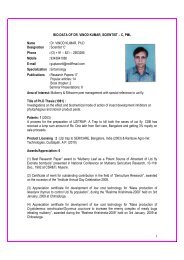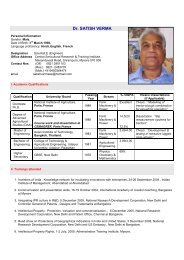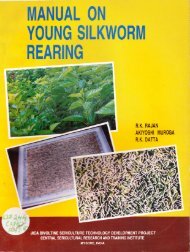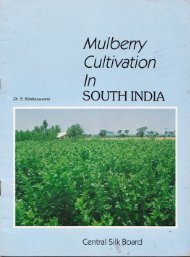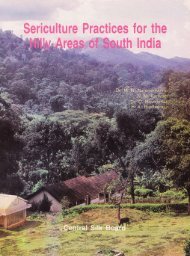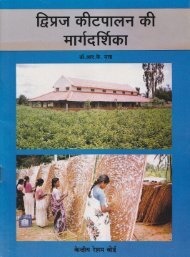Forewarning-white muscardine - Central Sericultural Research ...
Forewarning-white muscardine - Central Sericultural Research ...
Forewarning-white muscardine - Central Sericultural Research ...
- No tags were found...
You also want an ePaper? Increase the reach of your titles
YUMPU automatically turns print PDFs into web optimized ePapers that Google loves.
<strong>Forewarning</strong><br />
HOW TO MANAGE WHITE MUSCARDINE DISEASE<br />
DURING RAINY AND WINTER SEASONS?<br />
Dr. M. Balavenkatasubbaiah, A. R. Narasimha Nayaka and Dr. B. B. Bindroo<br />
<strong>Central</strong> <strong>Sericultural</strong> <strong>Research</strong> and Training Institute, Mysore – 570 008.<br />
Among the silkworm diseases, <strong>white</strong> <strong>muscardine</strong> poses a major threat to silk cocoon production<br />
during rainy and winter seasons. The rainy and winter seasons are congenial for the spread of<br />
<strong>white</strong> <strong>muscardine</strong> disease. This year, rainfall is good and well spread with the high environmental<br />
humidity, which may cause the outbreak of the disease. Hence, it is important to resort to<br />
appropriate management practices to prevent the outbreak of the disease at the field level.<br />
Causative agent: White <strong>muscardine</strong> in silkworm is caused by a fungus known as Beauveria<br />
bassiana. This pathogen also infects many lepidopteron insects including the mulberry leaf roller<br />
(Fig. 1) and Bihar hairy caterpillars.<br />
Predisposing factors: Low temperature with high humidity in silkworm rearing environment<br />
which generally prevail during rainy and winter seasons, may work as a pre-requisite for outbreak<br />
of the disease.<br />
Source of pathogen, infection and disease spread: White mummified silkworms / mummified<br />
alternate hosts are the major source of infection. On the surface of mummified larva, large<br />
number of conidia grows, which are spherical and light in weight. Later, the conidia detach from<br />
the larva, remain drifting in the air and spread the infection in the whole village. One diseased<br />
silkworm larva of the final instar produces millions of conidia and each one of them is capable of<br />
causing infection to new host through the integument. The infected larva dies within 3 -5 days<br />
under low temperature and high humidity conditions.<br />
Symptoms:<br />
• The silkworm larva affected with the disease becomes sluggish, ceases to move and finally<br />
dies.<br />
• After death, the corpse gradually hardens and fungus protrudes from the body and covered<br />
with <strong>white</strong> mycelia and finally conidia develop on the body.<br />
• The larva mummifies and looks like a chalky <strong>white</strong> (Fig. 2).<br />
• The pupa and moth are also infected by <strong>white</strong> <strong>muscardine</strong> and pupal body gets covered with<br />
conidia.<br />
Management of White <strong>muscardine</strong> disease:<br />
Conduct disinfection of rearing house, its surroundings and rearing appliances using<br />
recommended disinfectant with due care for its concentration, quantity and schedule.
Control alternate hosts of the pathogen in and around mulberry garden and silkworm rearing<br />
environment.<br />
Manage the humidity in the rearing house by providing good cross-ventilation.<br />
Dust dry slaked lime powder when silkworms settle for moult.<br />
Feed silkworms with adequate quantity of mulberry leaves to avoid the accumulation of left<br />
over leaves in the rearing bed. Make sure that the silkworm bed is dry and thin.<br />
If the silkworm rearing house temperature falls below 22ºC, raise it using room heater /<br />
charcoal stove.<br />
Collect <strong>muscardine</strong> affected larvae from the rearing bed before mummification, dust anti<strong>muscardine</strong><br />
bed disinfectant and finally burn them. Do not throw them on the street or feed<br />
to animals / birds.<br />
Dust Vijetha and Vijetha Supplement or Ankush bed disinfectant as per recommended<br />
schedule (Table 1) or dust any recommended anti-<strong>muscardine</strong> bed disinfectant as per the<br />
schedule.<br />
Table 1: Bed disinfectant and Schedule of dusting<br />
Schedule<br />
After each moult and on 4 th day of final instar<br />
On 3 rd day of 4 th instar, 2 nd and 6 th day of<br />
final instar<br />
or<br />
After each moult and on 3 rd day of 4 th instar, Ankush<br />
3 rd and 5 th day of final instar.<br />
Bed disinfectant<br />
Vijetha<br />
Vijetha Supplement<br />
These management practices will prevent the incidence of disease and help in ensuring<br />
successful cocoon crop harvest in rainy and winter seasons.<br />
Fig. 1 : Leaf roller larave infected with<br />
<strong>white</strong> <strong>muscardine</strong><br />
Fig. 2: Silkworm larvae infected with<br />
<strong>white</strong> <strong>muscardine</strong>




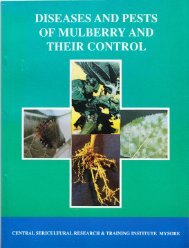

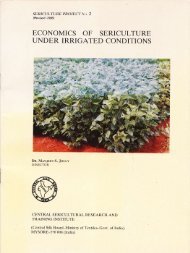
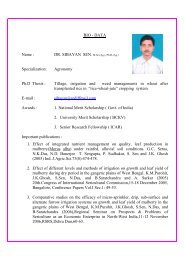
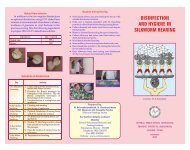
![E}A]\GALORE](https://img.yumpu.com/54052619/1/190x260/eagalore.jpg?quality=85)

